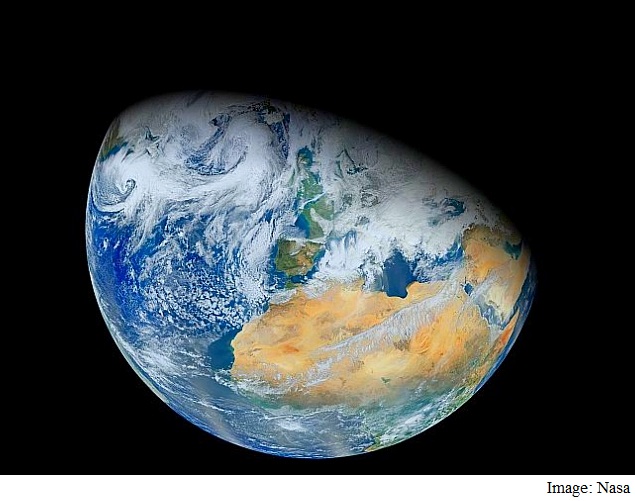- Home
- Science
- Science News
- Scientists Alarmed at Short Term Ozone Eroding Gases
Scientists Alarmed at Short-Term Ozone-Eroding Gases

Environmental scientists raised concern Monday at rising levels of gases that attack Earth's protective ozone layer, including manmade chemicals not covered by a key UN treaty.
Researchers at Leeds University in northern England said two computer models highlighted the impact of so-called "very short-lived substances" - VSLS - that deplete the stratospheric shield.
The damage they do to the ozone layer is significant and likely to increase, they said, as emissions of man-made chlorine gases rise.
Ironically, one of the chemicals named in the report, dichloromethane, is used in the manufacture of substitutes for ozone-depleting gases outlawed by the UN's 1987 Montreal Protocol.
VSLS are gases that have a short lifetime, usually breaking down in less than six months.
They are not covered by the landmark Montreal Protocol that requires the phaseout of longer-lasting chlorofluorocarbon (CFCs) and halon gases.
"Our model simulations indicate that VSLS account for a significant portion of ozone loss in the stratosphere," lead investigator Ryan Hossaini told AFP by email.
"In the Antarctic region, where the ozone hole forms each year and where ozone decreases are the most dramatic, we estimate that VSLS account for about 12.5 percent of the total ozone loss.
"Globally averaged, the ozone loss due to VSLS in the lower stratosphere could be as much as 25 percent, though it is much smaller at higher altitude."
Around 90 percent of VSLS are natural - they are bromine compounds produced by seaweed and the ocean's phytoplankton.
The rest is man-made chlorine gases, and their contribution to the VSLS total is rising fast.
"Dichloromethane appears to be one of the most abundant man-made VSLS that we know of," said Hossaini.
Compared with the notorious CFCs, dichloromethane's impact today is small. The computer models suggest it reduces the ozone layer by less than one percent, he said.
"However, our study also shows that the atmospheric concentration of dichloromethane has increased dramatically in recent years," said Hossaini.
(Also See: Astronomers Claim at Least 2 More Planets in Our Solar System)
"At some locations its atmospheric concentration has doubled since the late 1990s."
The study, published in the journal Nature Geoscience, looked at two decades of raw data provided by the US National Oceanic and Atmospheric Administration (NOAA).
Ozone is a three-atom molecule of oxygen. At ground level, as a byproduct of traffic pollution, it can be a dangerous respiratory irritant.
Ozone defence
But in the stratosphere, a layer that lies between 10 and 50 kilometres (six to 52 miles) in altitude, it is a life-saver: it filters out harmful ultraviolet light that can cause skin cancer and cataracts and damage crops.
The ozone "hole" - in reality, a thinning - occurs naturally because of extreme cold.
But it is also eroded by man-made chlorine compounds such as coolants in air conditioners and refrigerators, insulation foams and propellants in hair sprays.
Most of these are being phased out under the Montreal treaty, which has been ratified by all 197 UN members.
Last September, UN agencies said the ozone was "well on track" for recovery by mid-century, although fixing it over Antarctica would take longer.
Some of the progress, though, would be offset if VSLS continue to increase, the paper said.
It was unclear whether global warming would hasten VSLS emissions by unlocking ocean sources, Hossaini said.
The gases were, however, not contributors to the greenhouse gas effect, which is separate from the ozone hole as an environmental problem.
Instead, VSLS exert an indirect cooling impact through the ozone loss.
Catch the latest from the Consumer Electronics Show on Gadgets 360, at our CES 2026 hub.
Related Stories
- Samsung Galaxy Unpacked 2025
- ChatGPT
- Redmi Note 14 Pro+
- iPhone 16
- Apple Vision Pro
- Oneplus 12
- OnePlus Nord CE 3 Lite 5G
- iPhone 13
- Xiaomi 14 Pro
- Oppo Find N3
- Tecno Spark Go (2023)
- Realme V30
- Best Phones Under 25000
- Samsung Galaxy S24 Series
- Cryptocurrency
- iQoo 12
- Samsung Galaxy S24 Ultra
- Giottus
- Samsung Galaxy Z Flip 5
- Apple 'Scary Fast'
- Housefull 5
- GoPro Hero 12 Black Review
- Invincible Season 2
- JioGlass
- HD Ready TV
- Laptop Under 50000
- Smartwatch Under 10000
- Latest Mobile Phones
- Compare Phones
- Honor Magic 8 RSR Porsche Design
- Honor Magic 8 Pro Air
- Infinix Note Edge
- Lava Blaze Duo 3
- Tecno Spark Go 3
- iQOO Z11 Turbo
- OPPO A6c
- Samsung Galaxy A07 5G
- Lenovo Yoga Slim 7x (2025)
- Lenovo Yoga Slim 7a
- Lenovo Idea Tab Plus
- Realme Pad 3
- Moto Watch
- Garmin Quatix 8 Pro
- Haier H5E Series
- Acerpure Nitro Z Series 100-inch QLED TV
- Asus ROG Ally
- Nintendo Switch Lite
- Haier 1.6 Ton 5 Star Inverter Split AC (HSU19G-MZAID5BN-INV)
- Haier 1.6 Ton 5 Star Inverter Split AC (HSU19G-MZAIM5BN-INV)






![[Sponsored] Haier C90 OLED TV | Dolby Vision IQ, 144Hz OLED and Google TV in Action](https://www.gadgets360.com/static/mobile/images/spacer.png)









